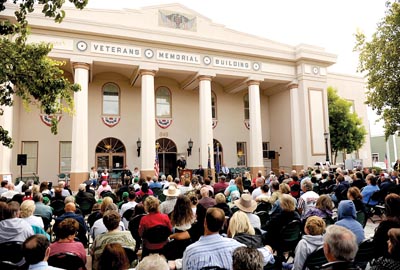
The city got itself into a mess with the Veterans Memorial Building and should fix the problems before handing them off to the nonprofit sector.
Hollister is less than a decade removed from the now-defunct redevelopment agency’s $4.4 million renovation of the downtown landmark, a memorial to county veterans. City leaders and other organizers had admirable intentions at the time of the renovation.
The building’s rebirth brought an infusion of community and national pride. It would be accessible to all, a central gathering place in Hollister’s core.
Nearly 10 years have passed in a decade defined by changing attitudes in Hollister, particularly when it comes to fiscal responsibility and a need for economic growth.
Unfortunately, officials’ approach toward the Veterans Memorial Building hasn’t changed with the times. The operation runs about a $75,000 annual deficit, as stated by the city, and there have been complaints about maintenance and management.
In a much different era for government in 2003 as it pertains to attitudes about spending, some city officials were open about the likelihood that the building would run a deficit – $175,000 the first year.
“We want to make sure we have as many residents in the community taking advantage of it,” then recreation manager Robert Ornelas said in April 2003, a month before its reopening. “This is not a revenue generating venture. If we break even, that would be great.”
In essence, Hollister taxpayers were going to subsidize a commercial enterprise that expected to lose money – while at the same time paying back $4.4 million, plus interest, in RDA loans for the renovation. Taxpayers, to make it worse, were funding a direct competitor to private businesses – a direct competitor that would always have a clear advantage over similar, but private, enterprises. The city’s veterans building could afford, or so they preached, to take the hit and absorb the deficits.
On one hand, the city was following a precedent set by many other communities managing similar rental-based operations. On the other, it reflects a monumentally flawed course when a public entity not only uses taxpayer money to subsidize an unnecessary commercial operation – the building largely serves as a cheap event hall for weddings and other weekend celebrations, not exactly a core government function – but does so while competing directly with businesses and hampering the local economy.
It is well past the time when municipal leaders should take a hard look at these types of operations and minimize any involved risks and structured financial liabilities.
Remember, Hollister taxpayers just approved the Measure E extension to the city’s 1 percent sales tax – with supporters arguing its failure at the polls would have led to fiscal demise and a steep drop in safety services – and yet this type of deficit still remains on the books. It is no wonder city officials who supported the tax waited until after the Nov. 6 election to broach the topic in public.
At a recent council meeting, City Manager Clint Quilter first talked publicly of prior discussions between the city and veterans groups about potentially handing off the building’s management to those nonprofits – the Veterans of Foreign Wars and American Legion.
Instead of shifting management to the local veterans groups, though, city leaders should first figure out why the Veterans Memorial Building runs a deficit, eliminate the liability and then develop a plan for its use that includes no taxpayer subsidies for any operations that compete with the private sector. If there are problems with maintenance and management as the veterans groups claim, then the city should examine those issues and figure out where the responsibility lies.
Officials can start with the building’s rate structure. If they insist on making commercial rentals the primary revenue source, then those rates must at least recoup all of the city’s costs. Since the renovation, those revenues have been nowhere near a break-even point.
Jumping ahead and handing over management to the veterans groups, meanwhile, incites too many questions.
What makes the city believe the veterans groups can run it any better?
How can the city protect its massive investment in the building while also giving a certain level of autonomy to the nonprofit organizations?
If the city hands over the building and continues subsidizing the current $75,000 deficit – an absurd notion – where in the world would Hollister ever find the financing for future renovations that will be necessary at some point?
And should city officials instead consider a public-private partnership, or at least explore prospective interest for such an arrangement?
There are too many unanswered questions and problems related to the building for the city to move forward on a complex agreement with the VFW and American Legion. For the sake of ensuring the memorial’s long-term security and financial stability, the city must fix its problems first and maintain a grasp, for now, on the building’s management.
We encourage city officials, particularly newly elected Mayor Ignacio Velazquez, to brainstorm and examine ideas to find the best possible long-term solution.









